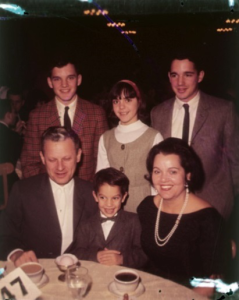Ron Schnur

Fourteen years ago, my parents, Bernard and Ruth Schnur, established a donor-advised fund to be managed by their four adult children, acting jointly. For family spirit and cohesion, this was a brilliant move. Year by year, my three siblings and I, in discussing each year’s recommendations, have deepened our attachment to each other in discussing our most important individual values — not abstractly, but in a focused, committed way to make specific decisions about what is worthy giving.
This is an enactment and a transmission of family values, established by my parents, but also influenced by their parents, whose tsedekeh (charity) extended to their childhood. My father has memories of his mother going from neighbor to neighbor during the Depression, collecting dimes because someone with no money needed medicine.
These family values aren’t vague notions, but have a quite specific architecture. My father conceptualized his values as a series of concentric rings of duty and obligation. At the center was his spouse. In the next circle was himself, on the principle that without due care to oneself, one won’t be much use to anyone else. Next were his kids, then family, then the local Jewish community, then Israel. These rings of duty demand responsibility from you, but in return give you a moral orientation, a plan of action, meaning and purpose. In other words, a way to be a better Jew and a better person.
But how to put these concepts into action? With insight, wisdom and efficiency, my parents decided on establishing a donor-advised fund for their children, one that would bring them together in years to come, in the context of talking about what is really important.
To get this started, my parents organized a meeting of their four adult children to explain their motivation and purpose in establishing the fund. They then went further to insist on generating a Memorandum of Understanding, which we were all to sign.
Benefits were immediate, because in jointly developing this Memorandum of Understanding, my siblings and I had to communicate seriously, listen to each other, explore our own values and come to a consensus. Ordinarily, we communicate in a good-natured banter, so this was a new dimension and an enhancement to our family relationship.
What was in the Memo of Understanding?
First, we decided that we would have a focus or theme. We decided on two areas: Jewish causes and environmental causes.
Second, we decided that we would favor organizations in which we had personal involvement — sweat equity — not just choosing organizations on the basis of a brochure or newspaper article.
Third, as a major emphasis, we committed that this fund is never to replace our personal tsedekah.
Fourth, we affirmed that the purpose of the fund is tsedekah, not to establish a perpetual memorial, and to that purpose that we would distribute at a rate that would run the fund down to zero by our 70’s — for us, in 20 to 25 years.
In writing this, a metaphoric image comes to mind of a violinist playing a melody. In this visual metaphor:

The violin is our fund.
The bow is the values that determine what the music will be.
The music is the tsekekah and the good things that come of it.
Ron Schnur
Princeton, NJ
